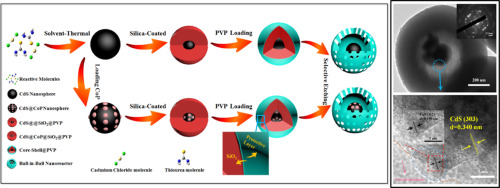Nano Energy ( IF 16.8 ) Pub Date : 2018-03-13 , DOI: 10.1016/j.nanoen.2018.03.026 He Li , Xiaoqing Yan , Bo Lin , Mengyang Xia , Jinjia Wei , Bolun Yang , Guidong Yang

|
Size-controllable interior cavity of the ball-in-ball [email protected]@SiO2 nano-photoreactor was fabricated using one-step hydrothermal method, Stöber method and combined with partially etching technique, and the size of inner-cavity can be precisely controlled with the different etching time. The experimental results show that the sample with a cavity diameter of 530 nm exhibits greatly higher photocatalytic activity and excellent stability compared with other sizes of inner-cavity samples and pure [email protected] sample, which could be attributed to its formed nanostructure properties, such as the proper inner-cavity distribution, visible light multi-scattering effect as well as reagent enrichment effect that confirmed by the NO removal reaction. However, noted that the ball in ball structure with interior cavity does not certainly improve the solar-driven hydrogen evolution under the visible light irradiation (λ ≥ 420 nm), as is evident from the photocatalytic activity of [email protected]@SiO2 (CSC-1) with a cavity diameter of 450 nm shows the lower hydrogen evolution than pure [email protected] sample. These results exhibit that the size of the confined space plays a significant role in enhancing photocatalytic activity of the as-prepared nano-photoreactor. In addition, in order to further proof the function of the spatial cavity and the universality of this ball in ball nanostructure, we also prepared a series of referenced [email protected]2 nano-photoreactor to validate again the spatial effect and apply in photocatalytic H2 evolution (HER). As a result, the referenced photo-reactors also reveal the similar photocatalytic trend of HER activity, which aids the suitable size of spatial cavity indeed plays a crucial part in boosting photocatalytic H2 generation and provides an innovative direction to further enhance HER activity. More importantly, exploring the factors over the different sizes of interior cavity can create a potential platform for designing the reasonable scale of the nanoreactor applied in other fields and efficiently accelerate the conversion of reactants.
中文翻译:

可控的空间效应作用于光诱导的[受电子邮件保护的] @SiO 2球形纳米光反应器,以增强氢的释放
球内尺寸可控的内腔,[SiO 2防护]纳米光反应器采用一步法水热法,Stöber法制备,并结合部分刻蚀技术,可以通过不同的刻蚀时间精确控制内腔的大小。实验结果表明,与其他尺寸的内腔样品和纯(受电子邮件保护的)样品相比,腔直径为530 nm的样品具有更高的光催化活性和出色的稳定性,这可归因于其形成的纳米结构特性,例如作为适当的内腔分布,可见光的多重散射效果以及通过NO去除反应确认的试剂富集效果。然而,腔直径为450 nm的图2(CSC-1)显示的氢析出量低于纯[受电子邮件保护的]样品。这些结果表明,受限空间的大小在增强所制备的纳米光反应器的光催化活性方面起着重要作用。另外,为了进一步证明空间腔的功能以及该球在球纳米结构中的通用性,我们还制备了一系列参考[电子邮件保护] 2纳米光反应器,以再次验证空间效应并应用于光催化氢中。2进化(HER)。结果,参考的光反应器也显示出类似的HER活性光催化趋势,这有助于适当大小的空间空腔,确实在促进光催化H方面起着至关重要的作用。2代,为进一步增强HER活性提供了创新的方向。更重要的是,探索影响内部空腔大小的因素可以为设计合理规模的纳米反应器应用于其他领域创造一个潜在的平台,并有效地加速反应物的转化。











































 京公网安备 11010802027423号
京公网安备 11010802027423号